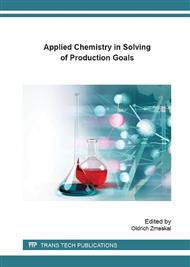[1]
E. Tipping, Cationic binding by humic substances, Cambridge University Press, Cambridge, (2002).
Google Scholar
[2]
M. Schnitzer, S.U. Khan, Humic substances in the environment, Marcel Dekker, Inc., New York, (1972).
Google Scholar
[3]
W. Kördel, M. Dassenakis, J. Lintelmann, S. Padberg, The importance of natural organic material for environmental processes in waters and soils (technical report), Pure. Appl. Chem. 69 (1997) 1571-1600.
DOI: 10.1351/pac199769071571
Google Scholar
[4]
J.D. Ritchie, E.M. Perdue, Proton-binding study of standard and reference fulvic acids, humic acids, and natural organic matter, Geochim. Cosmochim. Ac. 67 (2003) 85-88.
DOI: 10.1016/s0016-7037(02)01044-x
Google Scholar
[5]
M. Fukushima, K. Nakayasu, S. Tanaka, H. Nakamura, Chromium(III) binding abilities of humic acids, Anal. Chim. Ac. 317 (1995) 195-206.
DOI: 10.1016/0003-2670(95)00410-6
Google Scholar
[6]
F. De Paolis, J. Kukkonen, Binding of organic pollutants to humic and fulvic acids: Influence of pH and the structure of humic material, Chemosphere. 34 (1997) 1693-1704.
DOI: 10.1016/s0045-6535(97)00026-x
Google Scholar
[7]
Y. Ran, K. Sun, Y. Yang, B. Xing, E. Zeng, Strong sorption of phenanthrene by condensed organic matter in soils and sediments, Environ. Sci. Technol. 41 (2007) 3952-3958.
DOI: 10.1021/es062928i
Google Scholar
[8]
F. Stevenson, Humus chemistry: genesis, composition, reactions, John Wiley and Sons, New York, (1994).
Google Scholar
[9]
H. Martyniuk, J. Wieckowska, Adsorption of metal ions on humic acids extracted from brown coals, Fuel. Proces. Technol. 84 (2003) 23-36.
DOI: 10.1016/s0378-3820(02)00246-1
Google Scholar
[10]
H.B. Bradl, Y.S. Acikel, Adsorption of heavy metal ions on soils and soils constituents, J. Colloid. Interf. Sci. 277 (2004) 183-223.
DOI: 10.1016/j.jcis.2004.04.005
Google Scholar
[11]
M. Klucakova, M. Pekar, New model for equilibrium sorption of metal ions on solid humic acids, Colloid. Surface. A. 286 (2006) 126-133.
Google Scholar
[12]
M. Klucakova, M. Pekar, Study of structure and properties of humic and fulvic acids. IV. Study of interactions of Cu2+ ions with humic gels and final comparison, J. Polym. Mater. 20 (2003) 155-162.
Google Scholar
[13]
M. Klucakova, M. Kalina, P. Sedlacek, L. Grasset, Reactivity and transport mapping of Cu(II) ions in humic hydrogels. J. Soil. Sediment. 14 (2014) 368-376.
DOI: 10.1007/s11368-013-0730-2
Google Scholar
[14]
J. Smilek, P. Sedlacek, M. Kalina, M. Klucakova, On the role of humic acids' carboxyl groups in the binding of charged organic compounds. Chemosphere. 138 (2015) 503-510.
DOI: 10.1016/j.chemosphere.2015.06.093
Google Scholar
[15]
P. Sedlacek, J. Smilek, M. Klucakova, How the interactions with humic acids affect the mobility of ionic dyes in hydrogels – 1. Results from diffusion cells, React. Funct. Polym. 73 (2013) 1500-1509.
DOI: 10.1016/j.reactfunctpolym.2013.07.008
Google Scholar
[16]
P. Sedlacek, J. Smilek, M. Klucakova, How the interactions with humic acids affect the mobility of ionic dyes in hydrogels – 2. Non-stationary diffusion experiments, React. Funct. Polym. 75 (2014) 41-50.
DOI: 10.1016/j.reactfunctpolym.2013.12.002
Google Scholar
[17]
E.A. Ghabbour, A.H. Khairy, D.P. Cheney, V. Gross, G. Davies, T.R. Gilbert, X.Y. Zhang, Isolation of humic-acid from brown alga pilayella-littoralis, J. Appl. Phycol. 6 (1994) 459-468.
DOI: 10.1007/bf02182399
Google Scholar


